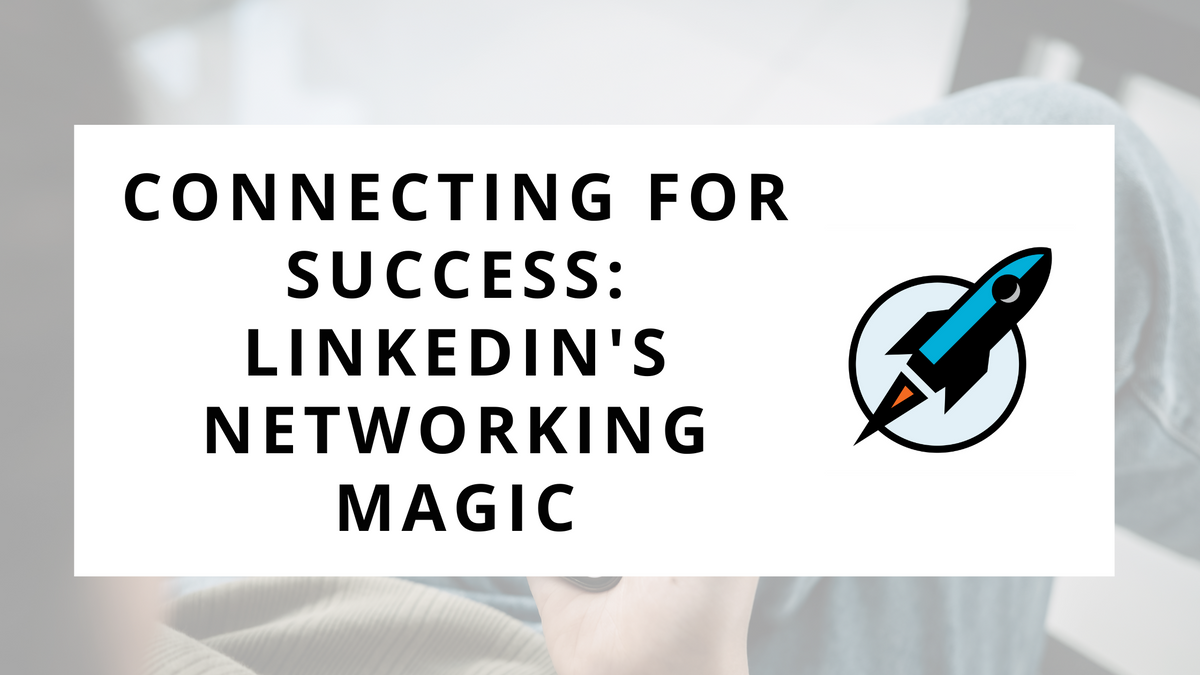Connecting for Success: LinkedIn's Networking Magic

In the world of social networking, your connections are a fundamental part of your social selling strategy.
Your connections are vital in how you interact with LinkedIn, including what shows up on your newsfeed, who you can engage with, and your ability to reach your desired audience.
Without connections, you have no network!
In this week’s Sell with Social, we will dive into LinkedIn connections. We’ll review why they matter, who you should connect with, and best practices for building your network.
Why Connections Matter
With all the talk around content, algorithms, direct messages, and hashtags, it’s easy to forget one of the most important aspects of a social selling strategy - your connections.
Who you are connected with plays a significant role in how you can execute your social selling activities.
Your connnections impact:
- Who’s Content You See - The content that shows up on your newsfeed will mostly be content from people you are connected with, or content that those people interacted with.
- Who Sees Your Content - Your connections will be the primary people who see the posts you make, as well as their connections if they engage with your content.
- Who You Can Message - Your ability to direct message people is determined by your connection level with them. Your connections are the people whom you can always message without using InMail credits.
- Who You Can Invite - When sending invites to business pages, events, or newsletters, you are limited to inviting your 1st connections. By growing this list with quality people, you're able to build better audiences for these tools.
But going beyond the “features” of how connections impact your social selling experience, it’s important to remember that connections are fundamental to the people side of social selling.
Each connection represents someone you can reach, provide value to, and potentially sell to.
Even further, your connection’s connections are valuable to your strategy.

If you build a strong network of first connections who regularly engage with your content, you’ll also begin to get visibility into their network of connections.
You can see how this can quickly become a powerful tool for networking!
Who should I connect with?
Let’s now talk about who you should be connecting with on social networks.
One piece of advice I’ll mention right away - don’t go with a “spray and pray” approach to connecting. Simply connecting to pump up your numbers is not a winning strategy.
Connections are about quantity AND quality.
Pretend you are at an in-person networking event. How would you meet with people?
Would you focus on meeting as many people as possible? Or would you focus on meeting as many of the right people as possible?
The same holds true for your social networking strategy. You want to connect with as many quality connections as possible. This will ensure that your reach and engagement of your social strategy is successful long into the future.
Bad connections, or irrelevant connections, will harm your ability to be successful. They’ll make reaching your target audience harder, ultimately converting less of your activity into profitable sales.
Here is who you should connect with:
Existing Customers: You should be connected with your primary contacts at your existing customers. This provides an excellent opportunity to stay in touch with them and expand your existing footprint within their business.
Co-workers: I always recommend connecting with your coworkers, as it allows you to support each other’s social selling strategy by commenting and sharing each other’s content.
Vendors: Connecting with suppliers and vendors is a nice way to grow your network with people mutually benefiting from your success. Your contacts at vendors are often happy to support you and your social selling strategy.
Industry Influencers: Seeking connections with industry influencers is a great way to expand your reach and learn more about the latest trends in your industry. While some of the BIG names might not connect with you, plenty of micro-influencers can dramatically increase your visibility.
Prospects: Yes, you should be connecting to prospects. No, you should not be connecting them and then cold-pitching them. Connect with them and then provide real value and build a genuine relationship.
Audiences: If you are hosting webinars, publishing newsletters, or creating video channels, you should be connecting with your audiences. Review your subscriber data and reach out to those already engaging with your educational content.
In-Person Follow-ups: You should always send connection requests to people you meet in person, whether at a tradeshow or in a planned meeting. This will provide another channel for you to continue the conversation with them.
The list could go on and on… As there are many people who you should be connecting with regularly to grow your network.
Again - the key here is quality and quality.
How Should I Connect?
Now that you know who you want to connect with, let’s discuss how to connect with them.
The process is pretty simple - you connect with people.
But like everything else in life, people like to complicate things. What if that person doesn’t want to connect with me? Should I add a personal note to the request? How should I follow up?
So, let’s walk through the basic steps of making a connection:
Step 1 - Request The Connection
Go to the person’s profile who you want to connect with, and smash that connect button.
I recommend adding a note to the connection. A simple sentence or two provides context on why you want to connect and tells them you look forward to adding them to your network.

Note - If they have creator mode enabled, you’ll see a “Follow” button instead. To connect with them, press the “More” button and then click Connect.
Step 2 - Send a Follow-up Message
Once they’ve accepted your connection request, send them a quick follow-up message.

DO NOT use this as an opportunity to send them a sales pitch. This message should be a simple “thanks for connecting” or another quick comment about your relationship with them.
Step 3 - Build the Relationship
Now, it’s time to leverage this new connection to build a relationship.
Since you’re connected, you may begin to see their activity on your newsfeed, as well as have access to more of the content on their profile. This provides an excellent opportunity for you to start commenting and reacting to their posts.
Invest the time in engaging with your connections to build long-term relationships, knowing that any of your connections could lead to a sale (either directly or indirectly through their network/referrals).

For this week’s action items, I want you to start intentionally growing your LinkedIn network.
Start to view your network as an asset you can leverage as part of your social selling strategy.
Here are the steps to take:
- Connect with 5+ People - Aim to connect to at least five new people daily. Remember, focus on quality and quantity. Use the list of suggested people above to get started. You can also leverage tools like Sales Navigator to find new prospects to connect with.
- Send Follow-ups - As people accept your requests, send a follow-up message. Show them you care about the relationship by acknowledging it with a thoughtful and personal statement.
- Start Engaging - Proactively engage with your connections by reacting, commenting, and messaging. Start to build relationships by showing up consistently and providing value.
Remember the old cliche - “Your network is your net worth.” Invest the time and energy in building your digital network to reach your full selling potential!
